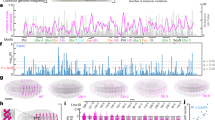Abstract
The mutants referred to as facultative dominant lethals were selected in the progeny of gamma-irradiated Drosophila males. The mutant males were viable and fertile, though their crosses with females of the yellow line yielded no daughters. The mutations obtained differed from the common mutations by (1) extremely varying penetrance of F1 hybrids from crosses with various lines; (2) the uncertain relationships between the mutant and normal alleles; (3) the different expression in somatic and germ cells; (4) the dependence of the expression on the sex of the parent that was the donor of the mutation; (5) the mass morphosis formation and (6) the frequent reversal to the norm. These mutations are assigned to the regulatory group and their specific expression (see above) can be helpful in identifying regulatory gene mutations. We assume that the specific expression of the mutations studied is related to specific properties of the regulatory genes. These properties are as follows: (1) only one out of two homologous regulatory genes is in an active state, (2) in the haploid chromosome set, the regulatory gene is represented by several alleles (cys-alleles); (3) only one allele ensures the regulatory gene activity.
Similar content being viewed by others
REFERENCES
Chadov, B.F., Chadova, E.V., Kopyl, S.A., and Fedorova, N.B., A New Class of Mutations in Drosophila melanogaster, Dokl. Akad. Nauk, 2000, vol. 373, no. 5, pp. 714-717.
Chadov, B.F., Mutations in the Regulatory Genes of Drosophila melanogaster, Proc. Int. Conf. “Biodiversity and Dynamics of Ecosystems in North Eurasia, ” Novosibirsk, August 21–26, 2000, pp. 16-18.
Chadov, B.F., Mutations Able to Initiate Speciation, Vid i vidoobrazovanie: Materialy Mezhdunarodnoi konferentsii, 3–5 oktyabrya 2000, Tomsk (Species and Speciation: Proc. Int. Conf., October 3–5, 2000), Evol. Biol., 2001, vol. 1, pp. 138-162.
Chadov, B.F., Chadova, E.V., Kopyl, S.A., and Fedo-rova, N.B., Delayed Activation of the Maternal Genome in Early Development of Drosophila, Dokl. Akad. Nauk, 2001, vol. 378, no. 6, pp. 841-845.
Chadov, B.F., Facultative Dominant Lethals: Genetics, Ontogeny, and Phylogeny, Evolyutsionnaya biologiya: Materialy konferentsii (Proc. Conf. on Evolutionary Biology), Stegnii, V.N., Ed., Tomsk, 2002 (in press).
Bridges, C.B., Non-Disjunction as Proof of the Chromosome Theory of Heredity, Genetics, 1916, vol. 1, pp. 1-52, 107-163.
Ashburner, M., Drosophila: A Laboratory Handbook, Cold Spring Harbor, New York: Cold Spring Harbor Lab., 1989.
Lindsley, D.L., Edington, C.W., and von Halle, E.S., Sex-Linked Recessive Lethals in Drosophila Whose Expression Is Suppressed by the Y Chromosome, Genetics, 1960, vol. 45, pp. 1649-1670.
Muller, H.J. and Zimmering, S., Sex-Linked Lethal without Evident Effect in Drosophila Males but Partially Dominant in Females, Genetics, 1960, vol. 45, pp. 1001-1002.
Zimmering, S. and Muller, H.J., Studies on the Action of the Dominant Female-Lethal F1 and a Seemingly Less Extreme Allele, Fls, Dros. Inf. Serv., 1961, vol. 35, pp. 103-104.
Maine, E.M., Salz, H.K., Cline, T.W., and Schedl, P., The Sex-Lethal Gene of Drosophila: DNA Alterations Associated with Sex-Specific Lethal Mutations, Cell (Cambridge, Mass.), 1985, vol. 43, pp. 521-529.
Dobzhansky, T., Ayala, F.J., Stebbins, G.L., and Valentine, J.W., Evolution, San Francisco: Freeman, 1977.
MacIntyre, R. and O'Brien, S., Interacting Gene-Enzyme Systems in Drosophila, Annu. Rev. Genet., 1976, vol. 10, pp. 281-318.
Ayala, F.J. and McDonald, J., The Role of Regulatory Genes in Adaptive Evolution, in Voprosy obshchei genetiki: Trudy XIV MGK (Problems of General Genetics: Proc. XIV MGK), Moscow: Nauka, 1978, pp. 92-107.
Davidson, E.H., Gene Activity in Early Development, New York: Academic, 1969.
Vingender, E., Classification of Eukaryotic Transcription Factors, Mol. Biol. (Moscow), 1997, vol. 31, no. 4, pp. 584-600.
Altukhov, Yu.P., Geneticheskie protsessy v populyatsiyakh (Genetic Processes in Populations), Moscow: Nauka, 1989.
Solter, D., Differential Imprinting and Expression of Maternal and Paternal Genomes, Annu. Rev. Genet., 1988, vol. 22, pp. 127-146.
Prokhorchuk, A.V. and Ruzov, A.S., Genome Methylation and Its Role in the Function of the Eukaryotic Organism, Genetika (Moscow), 2000, vol. 36, no. 11, pp. 1475-1486.
Redina, O.E., Genome Imprinting as a Universal Mechanism of Gene Functioning in the Course of Development, Genetika (Moscow), 1996, vol. 32, no. 5, pp. 609-613.
Korochkin, L.I., Vvedenie v genetiku razvitiya (Introduction in Developmental Genetics), Moscow: Nauka, 1999.
Hood, L., Cambell, J.H., and Elgin, S.C.R., The Organization, Expression, and Evolution of Antibody Genes and Other Multigene Families, Annu. Rev. Genet., 1975, vol. 9, pp. 305-353.
Singer, M. and Berg, P., Genes and Genomes: A Changing Perspective, Mill Valley, Calif.: Univ. Sci. Books, 1991, vol. 2.
Author information
Authors and Affiliations
Rights and permissions
About this article
Cite this article
Chadov, B.F. “The Image” of the Regulatory Gene in Experiments with Drosophila. Russian Journal of Genetics 38, 725–734 (2002). https://doi.org/10.1023/A:1016356418121
Issue Date:
DOI: https://doi.org/10.1023/A:1016356418121




